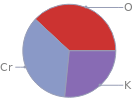Input interpretation

potassium dichromate | elemental composition
Result

Find the elemental composition for potassium dichromate in terms of the atom and mass percents: atom percent = N_i/N_atoms × 100% mass percent = (N_im_i)/m × 100% Plan: • Write the chemical formula and gather atomic masses from the periodic table. • Determine values for N_i, m_i, N_atoms and m using these items. • Finally, compute the percents and check the results. Write the chemical formula: K_2Cr_2O_7 Use the chemical formula to count the number of atoms, N_i, for each element and find the total number of atoms, N_atoms, per molecule: | number of atoms Cr (chromium) | 2 K (potassium) | 2 O (oxygen) | 7 N_atoms = 2 + 2 + 7 = 11 Divide each N_i by N_atoms to calculate atom fractions. Then use the property that atom fractions must sum to one to check the work: | number of atoms | atom fraction Cr (chromium) | 2 | 2/11 K (potassium) | 2 | 2/11 O (oxygen) | 7 | 7/11 Check: 2/11 + 2/11 + 7/11 = 1 Compute atom percents using the atom fractions: | number of atoms | atom percent Cr (chromium) | 2 | 2/11 × 100% = 18.2% K (potassium) | 2 | 2/11 × 100% = 18.2% O (oxygen) | 7 | 7/11 × 100% = 63.6% Look up the atomic mass, m_i, in unified atomic mass units, u, for each element in the periodic table: | number of atoms | atom percent | atomic mass/u Cr (chromium) | 2 | 18.2% | 51.9961 K (potassium) | 2 | 18.2% | 39.0983 O (oxygen) | 7 | 63.6% | 15.999 Multiply N_i by m_i to compute the mass for each element. Then sum those values to compute the molecular mass, m: | number of atoms | atom percent | atomic mass/u | mass/u Cr (chromium) | 2 | 18.2% | 51.9961 | 2 × 51.9961 = 103.9922 K (potassium) | 2 | 18.2% | 39.0983 | 2 × 39.0983 = 78.1966 O (oxygen) | 7 | 63.6% | 15.999 | 7 × 15.999 = 111.993 m = 103.9922 u + 78.1966 u + 111.993 u = 294.1818 u Divide the mass for each element by m to calculate mass fractions. Then use the property that mass fractions must sum to one to check the work: | number of atoms | atom percent | mass fraction Cr (chromium) | 2 | 18.2% | 103.9922/294.1818 K (potassium) | 2 | 18.2% | 78.1966/294.1818 O (oxygen) | 7 | 63.6% | 111.993/294.1818 Check: 103.9922/294.1818 + 78.1966/294.1818 + 111.993/294.1818 = 1 Compute mass percents using the mass fractions: Answer: | | | number of atoms | atom percent | mass percent Cr (chromium) | 2 | 18.2% | 103.9922/294.1818 × 100% = 35.35% K (potassium) | 2 | 18.2% | 78.1966/294.1818 × 100% = 26.58% O (oxygen) | 7 | 63.6% | 111.993/294.1818 × 100% = 38.07%
Mass fraction pie chart

Mass fraction pie chart